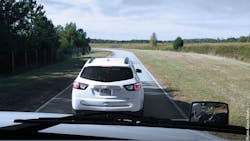Advanced truck safety systems are upping the technological ante by using data-ready "look ahead" systems like camera and radar to warn drivers and inform computer-controlled smart braking. Now, if they could only annoy drivers less.
That's exactly what truck OEM Navistar and likely others are looking to accomplish going forward, notes Stephen Gilligan, vice president of marketing at Navistar, who points out that some truck drivers get irked with such systems — particularly when they first encounter them.
"One of the things we hear is, 'Well, drivers hate this collision mitigation system because it's always going off,'" Gilligan tells Fleet Owner. "But it's always going off because it's warning them of their surroundings." Depending on the user interface, advanced safety systems in trucks typically deliver warnings in the form of progressively louder and/ or faster beeps, for example, as a dangerous object gets closer.
"You could imagine if you were driving a car and you had an alarm that was going off all the time, you would just desperately want to turn that thing off," Gilligan contends. So it's the same for heavy trucks: the challenge for these systems is, "how do you make that system do what it's supposed to do without driving the driver crazy?"
"How do you make that system do what it's supposed to do without driving the driver crazy?"—Stephen Gilligan, VP of marketing, Navistar |
Navistar is working with collision mitigation system companies, he says, to explore warning/ alert methods such as haptic feedback — vibration-based interactivity widely used in video game controllers and smartphones — to replace or augment other alerts. "You might be looking at something like a vibration in the seat that lets them know something's going on and to pay attention," says Gilligan.
Another option is that something like a flashing light alert in the dash could be combined with haptic feedback perhaps in the seat or steering wheel. The goal will be to deliver an effective "heads-up" to drivers without being bothersome.
Like antilock brakes
While advanced safety systems may gravitate toward subtler warnings, some truck drivers just need time to get accustomed to these latest safety technologies, Gilligan stresses. It's those moments where the systems can take over control of the vehicle, and drivers may find that unnerving — it's similar to wanting to grab the steering wheel during testing of more extensively or fully autonomous vehicles.
"Do you remember when antilock brakes first came around?" he asks, referring to the early '90s when those systems began to appear more. "It scared the heck out of people. You spent your whole life being told never to slam the brakes on — you feathered the brakes and so on.
"But antilock brake systems were smarter than the old systems, and suddenly you were supposed to just slam the brakes down and the system would do a better job of stopping you," Gilligan continues. "People are comfortable with that technology now, and the time frame [of drivers being uneasy with it] came and went."
In 2017 and beyond, look for more advanced safety systems proliferating in trucks that feature various levels of autonomous emergency operation. "I think we're going to see more systems like that that will potentially take control away from the driver," he contends, as well as more and more fleets opting for these advanced systems in their trucks.
Predictive, smarter machines
Other technology that's also gaining in use is likely to help pave the way for more driver assistive systems. Along those lines, global consulting and market analysis firm ABI Research points to predictive maintenance. As forward-looking maintenance becomes more common in trucks, it'll help drivers accept that vehicle systems are constantly monitoring data and sensors to detect and sidestep problems like parts failures before they ever occur.
That kind of predictive maintenance "is shifting the industry toward a machine-learning focus," says Susan Beardslee, a senior analyst with ABI. Ultimately, predictive maintenance and advanced safety systems, as Fleet Owner has reported, will be precursors to fully autonomous trucks. "Autonomous vehicles will not become a mainstream solution without the ability to predict failures and address them prior to transporting passengers. And for that, vehicle prognostics are a must," Beardslee expects.
By 2021, ABI Research predicts there will be more than 7 million "prognostics-enabled" commercial vehicle systems connected globally.
About the Author
Aaron Marsh
Aaron Marsh is a former senior editor of FleetOwner, who wrote for the publication from 2015 to 2019.
